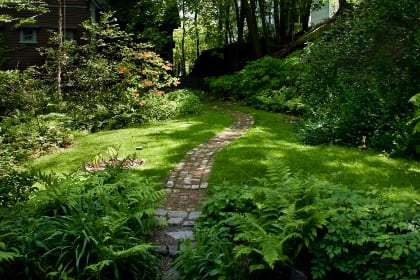by Benjamin Crouch
Here in Massachusetts we fondly use the abbreviated form of our state name – Mass. A common trait among all peoples seems to be fidelity to and pride in our home, our place. Yet, in a globalized market, there are fewer opportunities to revel in the pride of a product that originates within the politically designated bounds that we accept as our definition of “home.” The big box stores now give cursory deflection to the idea of “local,” but convenience tends to trump neighborliness in a world of commercial ease.
Exactly what do we gain when we look for the local brand? The quality that comes from pride in craft? Something unique that signifies pride of place? Or maybe something that identifies with the maker or producer of the object? There, a relationship is formed. When it comes to developing great gardens, I find that relationships trump brands in the trade.
The local product becomes personal and the brand a human being. There is Will the sawyer who cuts the locust. There is Ethan the farmer who provides the stone as byproduct. And, in some cases, the ancestral owners of the properties who left some goodies behind, in left-over collections and even waste-piles from their activities, that can be used to beautify the landscape.
 Brick
Brick
Case-in-point is this walkway in Jamaica Plain. A mason must have owned these grounds as evidenced by all the brick and cobbles that litter the embankment. We harvested the bricks to open up space for more plants to grow. An embankment that was once barren and derelict now flushes green with spreading deadnettle groundcover and native plants such as jewelweed and white snake root. Once the soils were relieved of rubble, we were able to plant native trees like black cherry and pagoda dogwood to fill in the understory.
 In November, 2010, we used the bricks to build a snaking walkway through the yard. The brick is a combination of whole and fractured pieces. Many of them are still washed with a layer of mortar. The lighter colored bricks add contrast and reveal the course of the pathway at night in an otherwise unlit space.
In November, 2010, we used the bricks to build a snaking walkway through the yard. The brick is a combination of whole and fractured pieces. Many of them are still washed with a layer of mortar. The lighter colored bricks add contrast and reveal the course of the pathway at night in an otherwise unlit space.
By re-using the unsightly waste product that littered the property we created an instantly aged piece that blends in with the old buildings and established landscape. The walk connects the deck of the residence to the carriage house, which is used for storage and workshop space. The sweep follows the contours of the mature gardens, which are planted and maintained to have an informal, forest-like appearance. The garden was developed over thirty years, preceding my involvement in the landscape.
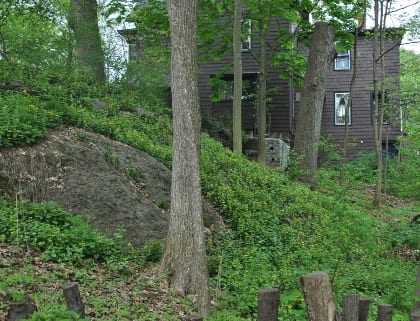
The woodlot has recovered its forb and shrub layer after removal of the dumped bricks and soil reconditioning.
Stone
Local farms produce a number of byproducts that are useful to the landscaper and gardener. New England farm fields are a source of a seemingly endless supply of beautiful, multi-colored glacial stone that most farmers will be happy to dispose of.
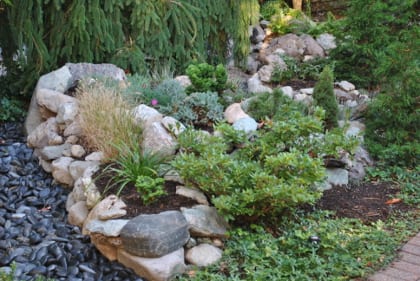 These rock gardens are constructed with native field stone from the farm across the street. The farm hands pick and pile the stone after a fresh till in the spring. We handpicked the stone, loaded the truck, and delivered it to the job site: a duplex in a neighboring upscale housing complex.
These rock gardens are constructed with native field stone from the farm across the street. The farm hands pick and pile the stone after a fresh till in the spring. We handpicked the stone, loaded the truck, and delivered it to the job site: a duplex in a neighboring upscale housing complex.
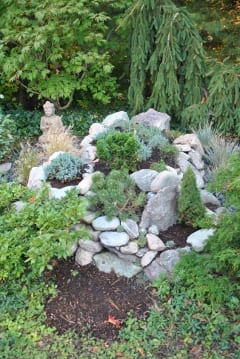 The client wanted some space and relief in her Japanese-inspired garden along her front entry walk. The solution was to build what are essentially planters with carefully placed dry stacks of stone and fill with compost-boosted soil. The polished river stones were an element included from the original layout conceived by a previous contractor. We used them to create an effect reminiscent of water, dividing the planters and other sections of the garden.
The client wanted some space and relief in her Japanese-inspired garden along her front entry walk. The solution was to build what are essentially planters with carefully placed dry stacks of stone and fill with compost-boosted soil. The polished river stones were an element included from the original layout conceived by a previous contractor. We used them to create an effect reminiscent of water, dividing the planters and other sections of the garden.
The plants included an assortment of miniature evergreens placed at varied elevations. The evergreens were accented with grasses, pinks, and ferns. The multiple elevations contain plantings of differing themes.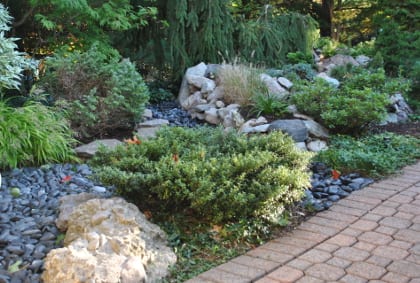
A native puddingstone boulder provides an accent close to the house entry. Mature ornamental trees and shrubs surround the planters. An assortment of spring bulbs and hens and chicks dot the crevices for added interest.
Wood
The independent sawyers of Massachusetts have access to a variety of woods that are difficult to find in the lumber yards. I have been ordering rough-cut black locust from a small operation out of Sheffield, MA for a number of years. The lumber is perfect for creating raised beds. It is more rot resistant and durable than pressure-treated lumber and is safer for growing vegetables because it is not treated with hazardous chemicals.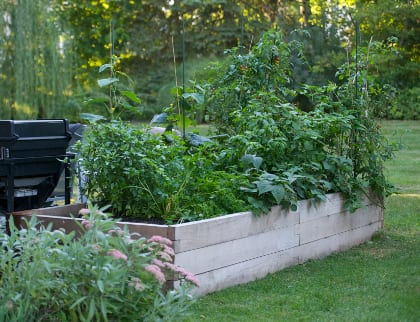
Though more expensive than treated lumber and harder on drill bits and saw blades, rough-cut locust is still affordable. Its durability makes it a great value. Locust posts still dot the countryside in my native New York state. The pasture in the backyard of my parents’ house is still fenced with posts erected in the early seventies.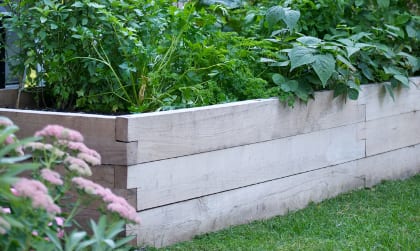
These photos show the structure after a year of aging. The locust ages to a deeper, mottled chestnut brown.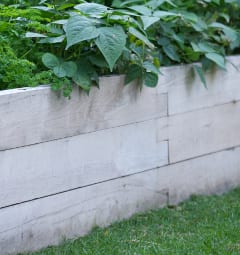
This L-jointed 11’x4’x18” bed hides the support structure and gives the bed an elegant-looking finish. Stainless steel threaded rods hold together the joints, while a stainless steel support beneath the soil keeps the long runs from buckling. The height makes it rabbit-proof and easier to tend.
About the Author
Benjamin Crouch is the proprietor of Land of Plenty, specializing in edible and naturalistic landscapes for Greater Boston. Ben was previously Urban Orchards Director for the Boston-based non-profit EarthWorks. For more information about Land of Plenty, go to www.landofplentygardens.com.

